
The Towards Action is a two-year initiative supported by the European Union’s Youth Participation funding. The project focuses on methods of civic engagement, as well as exploring agency and active citizenship. The project began at the start of 2024.
The idea and core principles of the project stem from feedback provided by participants of the Growing Change project held in 2023. This initiative was centered around food systems and food activism, exploring sustainable alternatives within our food systems and opportunities for participating in change. Towards Action takes a broader perspective, examining aspects of agency and an active civil society—exploring agency, methods of influence, new approaches to action, and collective forms of activity.
During the first year of the project, we have explored two themes: activism in general (what does it mean, and what could it mean?) and art as a means of agency and action. The project has a total of four main themes, each serving as a focus for six months. In the first year, activism and art were the guiding themes for activities and initiatives.
This page brings together the events and development of the project in one place, and we hope it also serves as an example and inspiration for other unifying and activating initiatives! This page is not updated frequently — all upcoming events for the Towards Action project can be found in Dodo’s newsletter and on Instagram.
Subscribe to Dodo’s newsletter here!
Dodo on Instagram
CONTENTS
2025
Direct action
“When dusk falls” study group
The Action weekend in Oulu
2024
Art
“Liminal spaces” study groups
The Action weekend in Tampere
Activism
“Communities, connections and action” study group
The Action weekend in Turku
THE SPRING 2025 – DIRECT ACTION!
This Spring our theme in this project was direct action. What is it — and what could it be? What kind of a role does it have as a part of an open, democratic society? How has direct action effected our fundamental rights?
The Towards Action project is based on enabling new forms of action and coexistence.
As the starting point for all of this, we aim to experiment with the new, to learn from these experiences and to build on them for the future. The various experiments, activities, successes and failures of the first year of this project’s lifetime will guide our plans this year: we hope to bring new contents together and to create co-learning opportunities, to host spaces to pause and be in (and build) community and to organise activities which allow new practices, knowledge and approaches to take space.
Based on what we have tried and learned during the year 2024, again this Spring we organised a study group and the Action weekend. The study group consisted of three gatherings instead of six like previous times. Less gatherings, but more within resources and time to prepare and adjust details.
Study group 1/25
”When dusk falls — a study group about direct action”
Helsinki
“When the dusk falls, the world looks different. The eye searches for new surfaces and the environment is drawn in new perspectives.” When dusk falls was a study circle consisting of three sessions about direct action. The purpose of the study circle was to come together around the theme to reflect and explore its different dimensions. To support the discussion, the study group used extracts from the book Suoraa toimintaa – Autonomiset liikkeet Suomessa 1986-2016 by Anton Monti and Pontus Purokuru. Each session of the study circle focused on certain themes from the book and specialists, related to the current theme, joining us!
In prevailing world situations, knowledge and experience are fragmenting and conversational connections are becoming differentiated. It is critical to create spaces that invite us to come together to listen to each other and imagine the possibilities of a good life. Direct action has been and will continue to be a critical part of democracy: through it we have achieved many of our fundamental rights. In this study group we reflected on the past, present and future forms of direct action and its potential. The goal was to make room for different views, listen to each other and learn together. Our three themes were based on the book, but also on topicality and reoccurence. More about each session and theme below.
I
Autonomous spaces (April the 23th)
The first session focused on direct action in urban environments, occupation movements and urban autonomous spaces.
This session was accompanied by two active guests from different movements – one of the guests was involved in the Oranssi occupations in the 1990s. Oranssi took over old houses that were facing demolition and renovated them into affordable housing for young people in the midst of the housing shortage in Helsinki. Oranssi is still active today, providing affordable housing and self-determined cultural activities. The other guest of this session has been involved in the more recent squatting movement, where one of the focuses has been the creation of autonomous and non-commercial spaces for cultural and social activities.
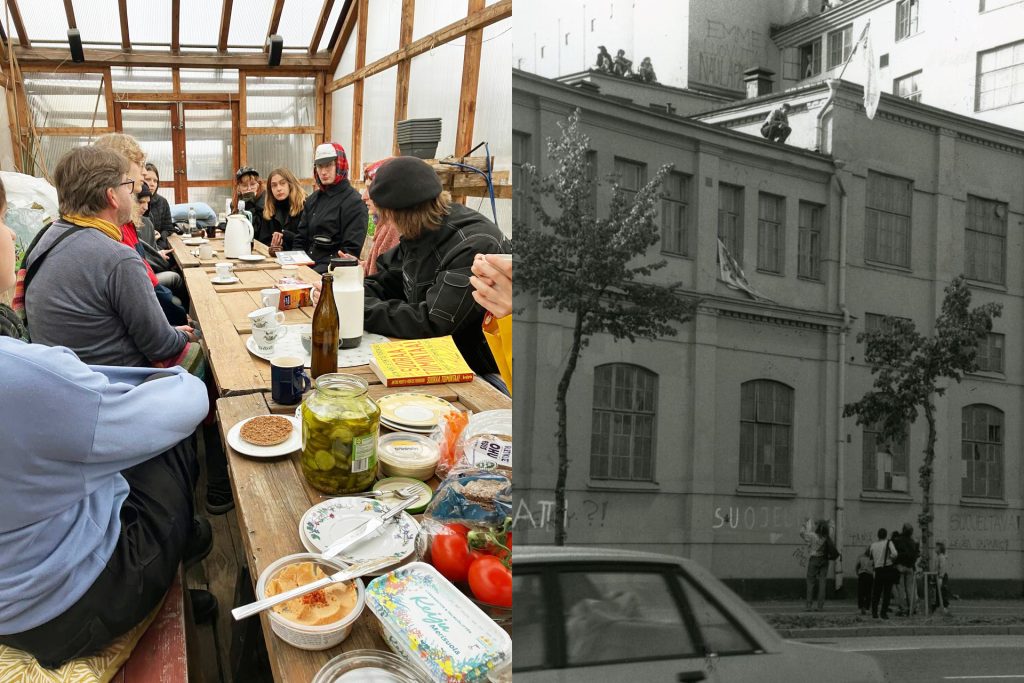
Left: Ardent discussion with the visitors going on.
Right: The occupation of Kookos (Haapaniemenkatu 6, Helsinki) going on in 1990. This occupation became an important meeting point and turned into a social center. The occupation ended up to save the building, which nowadays is used by the Theatre Academy (Copyright Työväenmuseo Werstas).
Together with the guests we discussed the manifestations and possibilities of autonomous spaces. We reflected on the reasons why people have started to look for and to organise spaces for alternative urban culture. What has been the role of the city in providing possibilities to bring people together to create and enjoy culture and community? Why and how have people started to occupy abandoned and empty buildings and what has come out of this?
We looked into the events of the 90’s squat and occupation movement and how it has affected the use of urban space, local culture and people’s lives. On top of this we discussed about the current state of autonomous and alternative culture, the importance low and zero-cost spaces and the possibilities to create community and build something meaningful together…
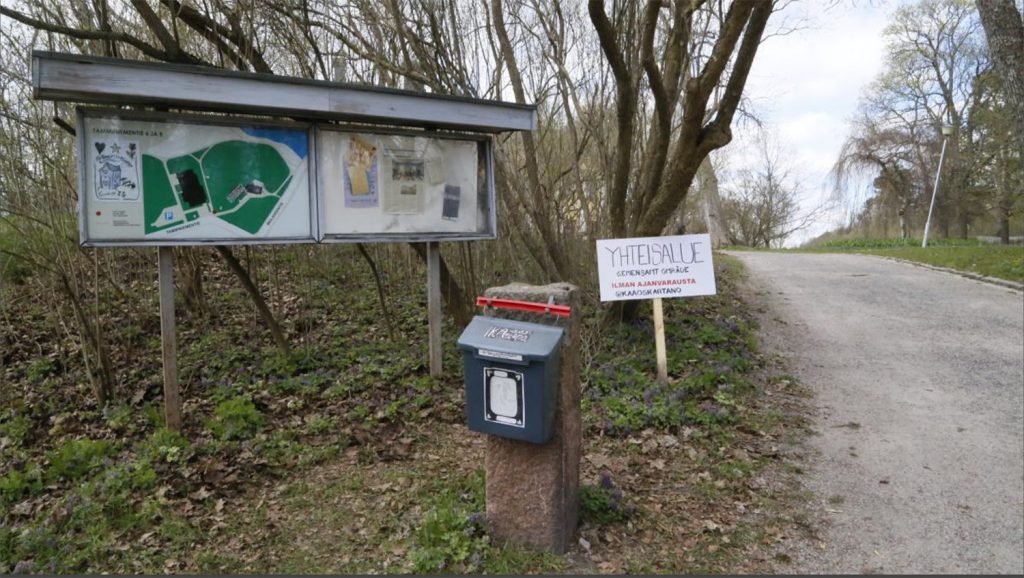
The entrance of Kaaoskartano’s occupation in Meilahti, Helsinki 2024. The sign says Yhteisalue (=common property). Kaaoskartano was running an autonomous social and culture center in this old occupied manor for some months. (Copyright Työväenmuseo Werstas).
We hope this session provided a good look into the events of the past few decades and the reasons why people have taken action. It was delightful to see how many needs and reasons for actions have not changed over time and how the current movements are actively working for the same causes. We also hope the session made our participants to reflect on the current urban environment and its limitations and possibilities, the crucial role of self-driven spaces in creating new culture and the importance of zero-cost spaces in building community.
II
Action for life (May the 7th)
The second session focused on action for life – meaning direct action by the animal rights movements in Finland and elsewhere.
Together with our guest, Kristo Muurimaa from Oikeutta Eläimille, we discussed the different manifestations and possibilities of the animal rights struggle. How can we disrupt life-destroying forces and offer freedom and new opportunities to others? Where do we draw the boundaries of our actions? What risks are worth taking? What makes an action legitimate?
We discussed and exchanged thoughts about the definitions of legit actions and what could be justified and when. This steered us into a discussion about speciesism and how the value of life differs and how different rights and laws are being applied to different beings. This session provided a great setting for observing the complexity of the balance in between of justification of actions and the end goal.

Left: During each session we served sandwiches and warm drinks.
Dodo’s greenhouse started to get a bit green by the second session in the early May.
Right: A page from the book “Suoraa toimintaa – Autonomiset liikkeet Suomessa”.
In this project we have approached direct action via this definition: direct action is an active form of political protest that derives its general legitimacy from the pursuit of the common good and its specific legitimacy from the compatibility of the means used with the end goal. This is a translated quote from the Pro Gradu thesis by Maarit Laihonen (2020, Helsinki University). The second session of the study group brought us to the very core of what direct action is about and how sometimes it could be the only way to build a righteous, democratic society.
III
Global solidarity (May the 21st)
In the third time of the study circle, we will look at global solidarity action, the political means it uses and its relationship with direct action. This time were joined by two guests from the global solidarity movement, who have been active in organising actions and demonstrations locally, in order to create political pressure and to disseminate information.
We discussed what means solidarity action uses and why, what is the political pressure and what kind of protest cultures have existed and could possibly exist. What scales of action can we outline? In what ways does the local connect with the international and the international with the local?
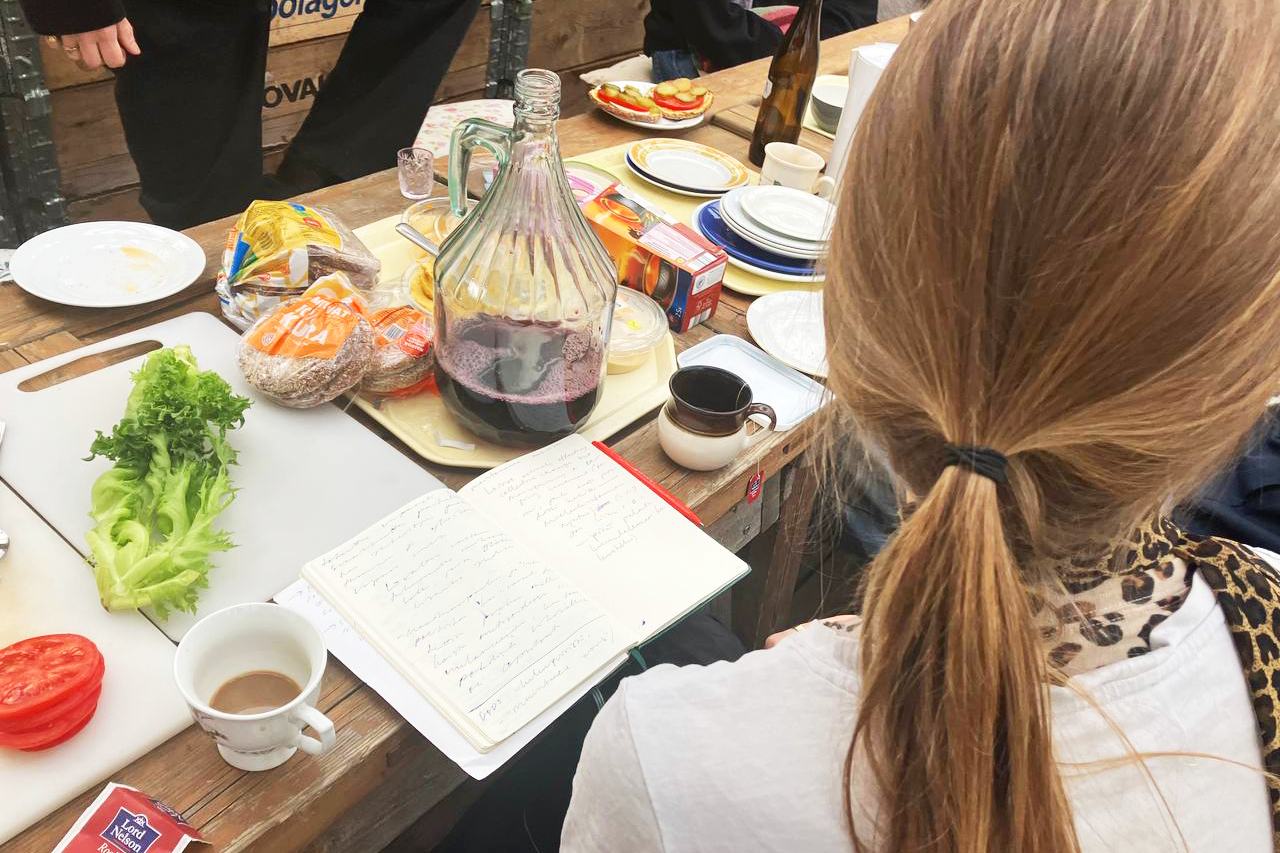
Making notes and enjoying blackcurrant juice and sandwiches while discussing.
In this session we reflected on our possibilties to affect something which happens far away from us. Are there ways to have an influence on something which does not take place within our living surroundings? What could a demonstration do? How could creating political pressure effect – and how to create it? Are there other ways of taking action?
Thank you!
Thank you everyone who participated this study group! We hope these sessions provided you a good look to what’s happened in the recent history of activism and what is to be learned from it. We also hope you gained new knowledge, visions, connections and perspectives to your own possibilities of finding important matters and taking action for them in the open democratic society.
We also want to thank all our visitors for all your invaluable input – it has been very inspiring to learn about the actions and the reasons behind of them, methods and practicalities but also to dive deeper into the philosophies behind agency and initiation.
To steer discussion, we used “Suoraa toimintaa – Autonomiset liikkeet Suomessa 1986-2016 by Anton Monti and Pontus Purokuru” book in this study group. Thank you Into Kustannus, Anton Monti and Pontus Purokuru for your support. And lastly, to give you a more visual experience on this website we have used some images owned by Työväenmuseo Werstas – thanks for letting us use the pictures!
The Action weekend (May the 16-18th)
Hietalinna, Oulu
The project’s third Action weekend happened this time in Hietasaari, Oulu. We stayed this beautiful Spring weekend at Hietalinna leisure house of the Finnish Red Cross. The place provided us a lovely setting for getting together and creating a warm and caring atmosphere.
Also this time the Action weekend’s program was composed mainly from different workshops, but this time the program also contained a direct action-themed movie night and some other interesting opportunities to inspect direct action in different lights. A big part of this weekend was made possible by our workshop facilitators, who all are involved to civic activism and are familiar with organising and planning actions on climate, human rights and social justice related struggles.
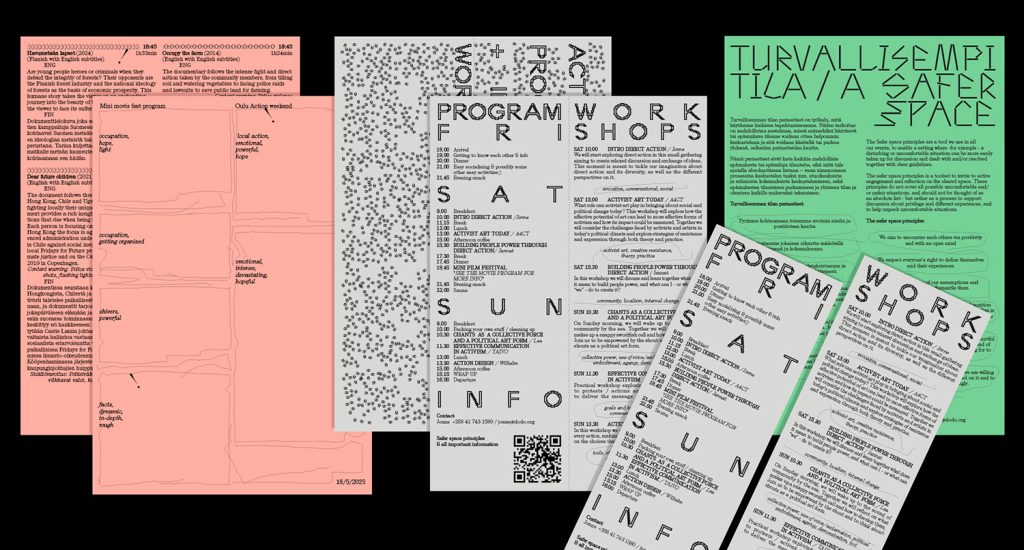
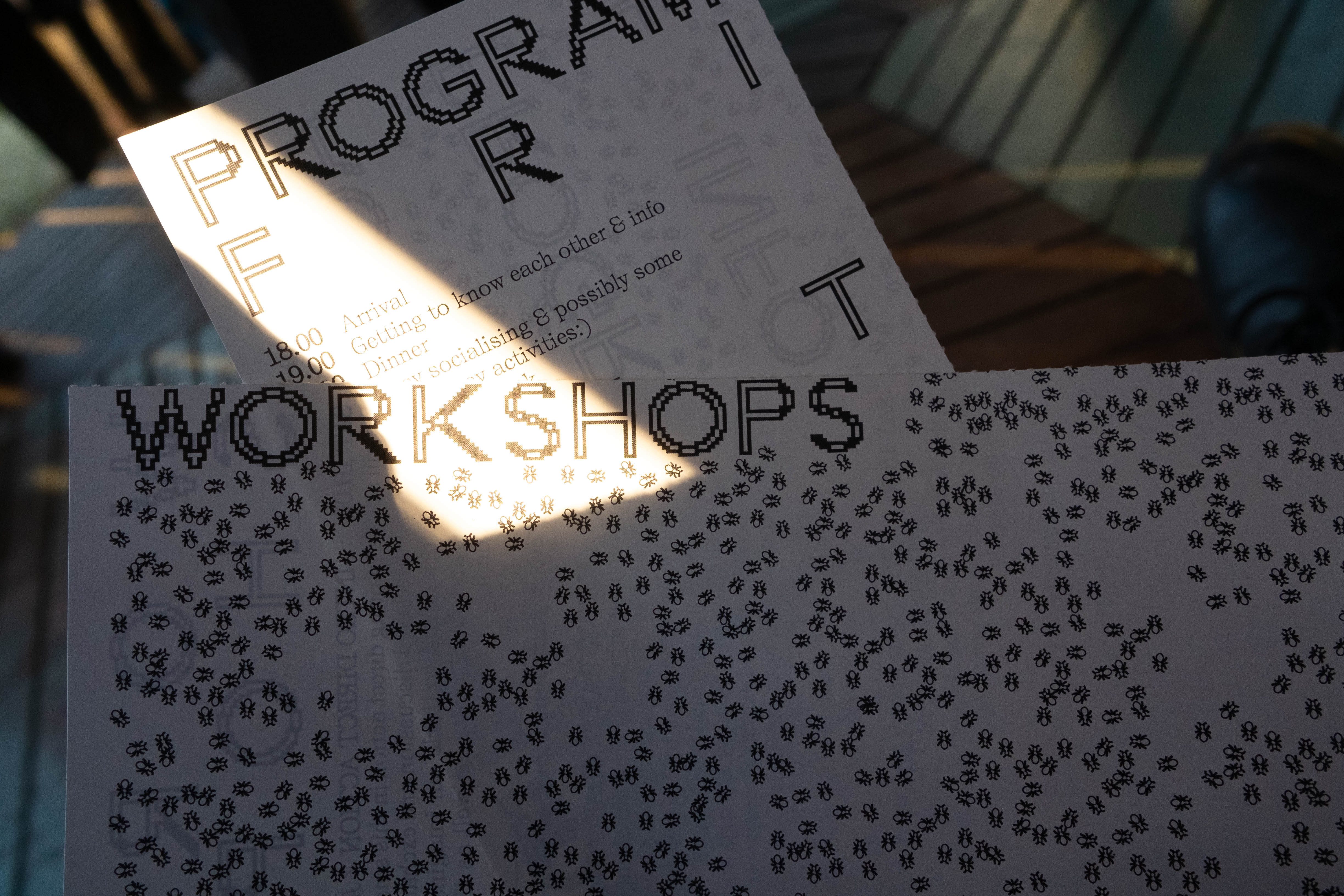
The printouts. The program, all workshop info, the mini movie fest program and the safer space principles were given to participants as print handouts. This was meant to help in grounding in the middle of the activity-rich weekend. All needed information was collected into these printouts but also into an online document.
Here is a small peek into the activities of our program. The workshops were designed by the facilitators and then composed together in our preparatory meetings. The program was designed so that it would create a chronological and comprehensive set all together, but at the same time allowing people not attend only some of the workshops and still be able to get everything out of it. We used keywords in our program to describe what to expect in each activity. The idea was to give away a bit about the approach each activity would take and to help people adjust their plans based on how they were feeling. The keywords used in italic under the descriptions.
Intro to direct action / Jonne
We started exploring direct action in our Saturday morning’s intro gathering including relaxed discussion and exchange of ideas. This intro moment was meant to tickle our imagination about direct action and its diversity, as well as the different perspectives on it. The goal was not to find answers to anything really, but to explore questions which hopefully were answered during the weekend in other activities.
evocative, conversational, grounding, relaxed, social
Activist art today / A4CT
What role can activist art play in bringing about social and political change today? This workshop explored how the affective potential of art can lead to more effective forms of activism and how its impact could be measured. Together we considered the challenges faced by activists and artists in today’s political climate and explored strategies of resistance and expression through both theory and practice.
activist art, creative resistance, theory, practice
More about A4CT here:
https://artivism4ct.cargo.site
Instagram: @artivism4ct

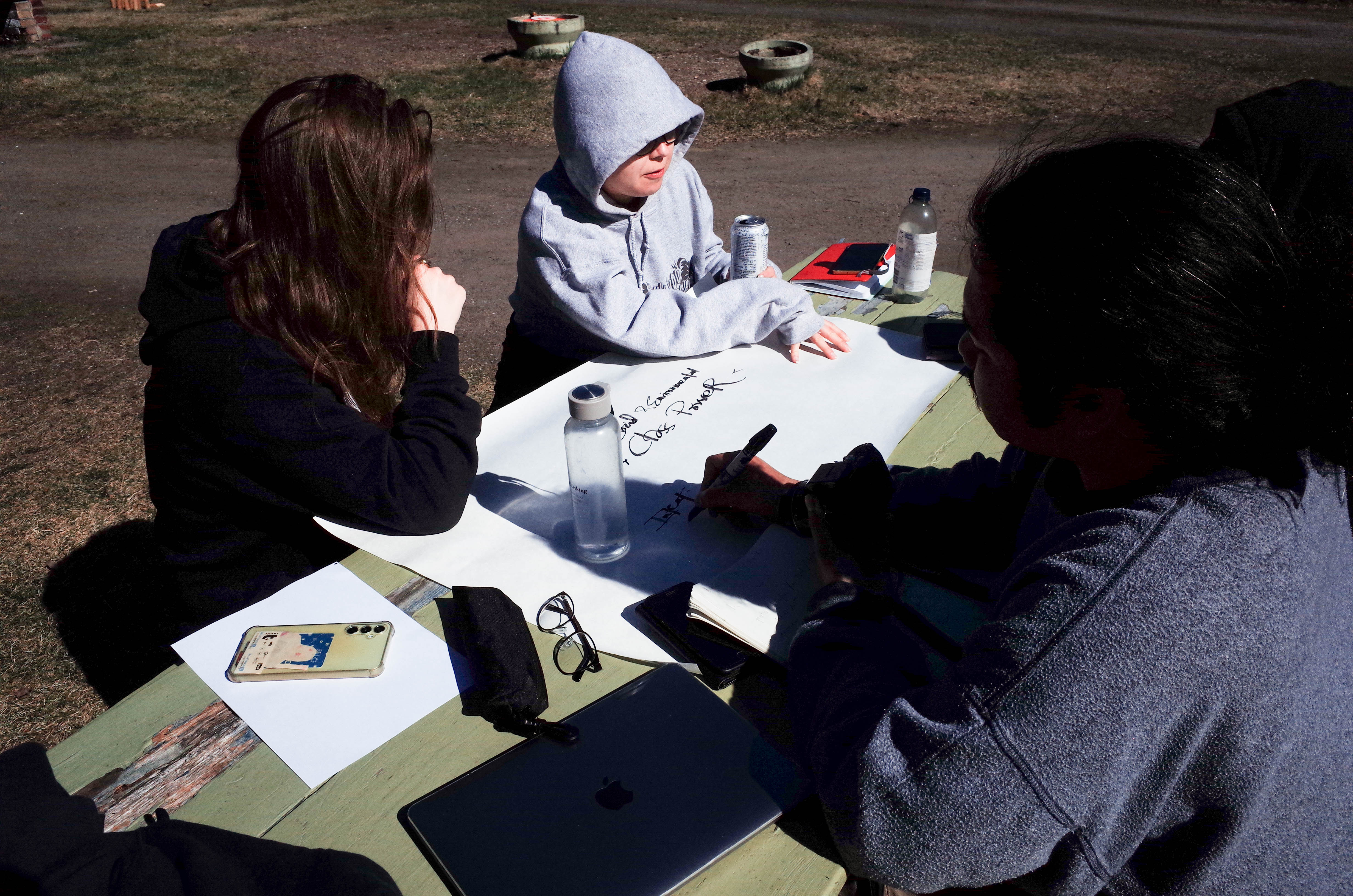
Building people power through direct action / Jannat Rahman (Regeneration 2030)
In this workshop we discussed and learned together what does it mean to build people power,
and what can I – or what can “we” – do to create it? This very powerful workshop guided us into taking another look how we perceive community and building it. We were nvited to study the needed changes within ourselves, in order to find each other and build something.
community, localism, internal change, theory
More about building people power on Regeneration 2030’s website!
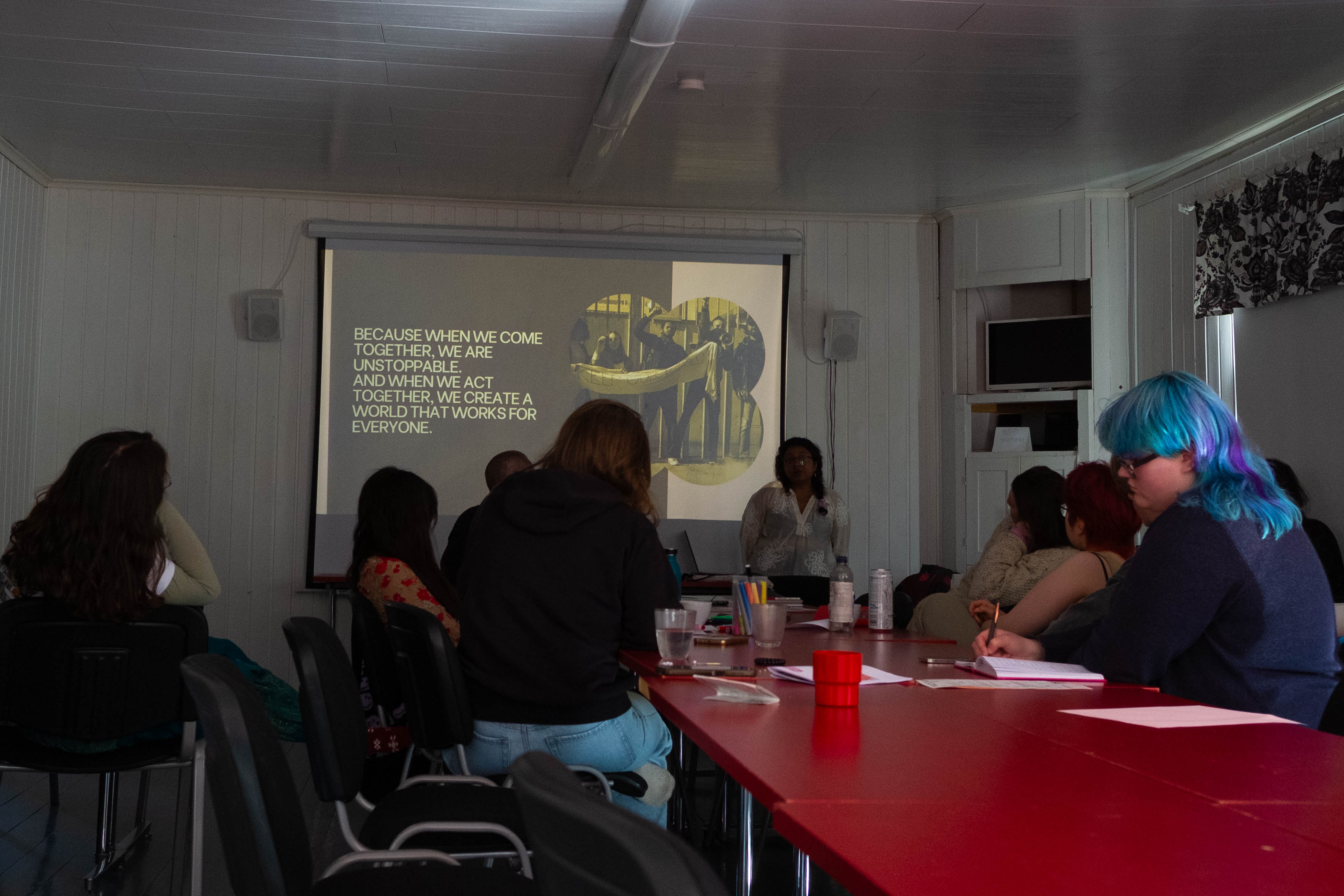
The mini film fest
The saturday night was dedicated for movies and documentaries. There were always two screenings happening simultaneously, in two different rooms. People would choose what they wanted to see, deciding based on descriptions but also keywords we had provided. This hopefully helped in choosing the most intriguing movies and documentaries from the many and in designing the individual program for the night.
All movies and documentaries were about direct action – displaying its different forms, reasons and outcomes in different location around the world. With selection of films we wanted to give a look into how taking action from different starting points and in different societal settings might make a great difference. What’s possible to some is not possible to all – what’s optional to some is not optional to all. The movie night provided a great possibility to pause and learn about the reasons of taking action of individuals living in very different settings. While we wanted to display the diversity of the reasons why people take actions, we also wanted display how in the end many struggles are common and how we are in this world together.
local action, emotional, powerful, hope, occupation, hope, light, getting organised,
emotional, intense, devastating, hopeful, shivers, powerful, acts, dynamic, in-depth, rough
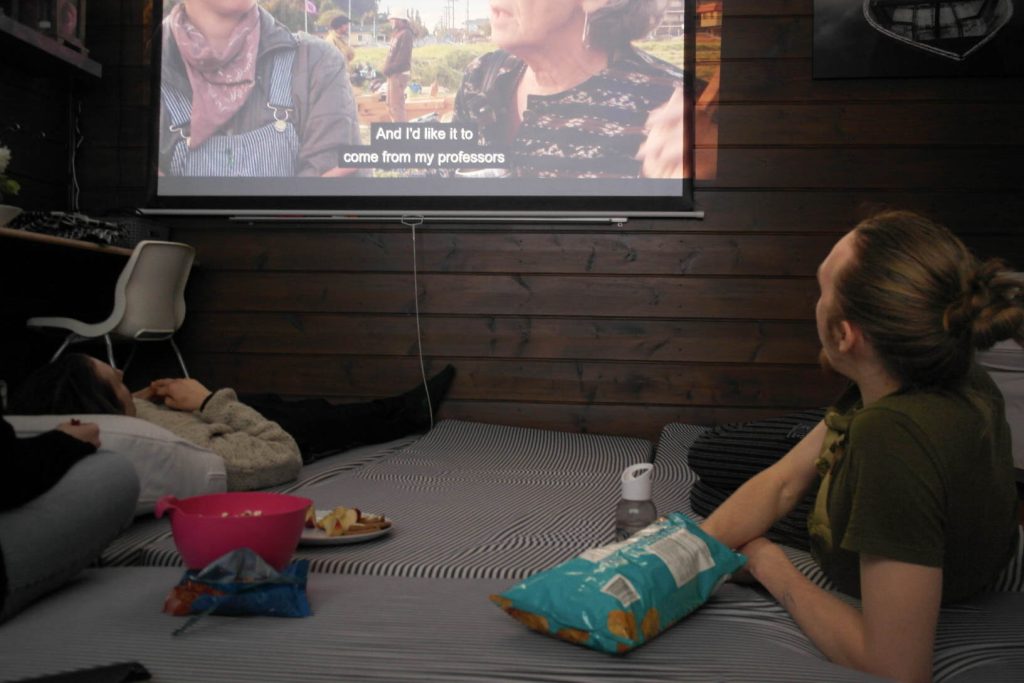
Occupy the Farm
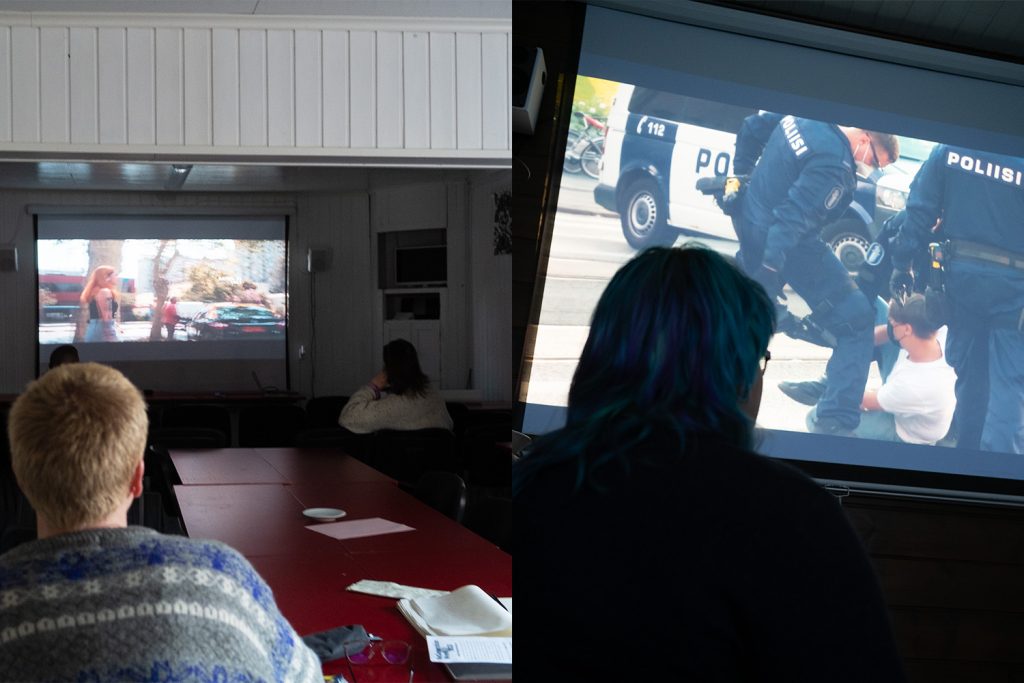
Left: Dear Future children
Right: Kuinka korjata Maailma?
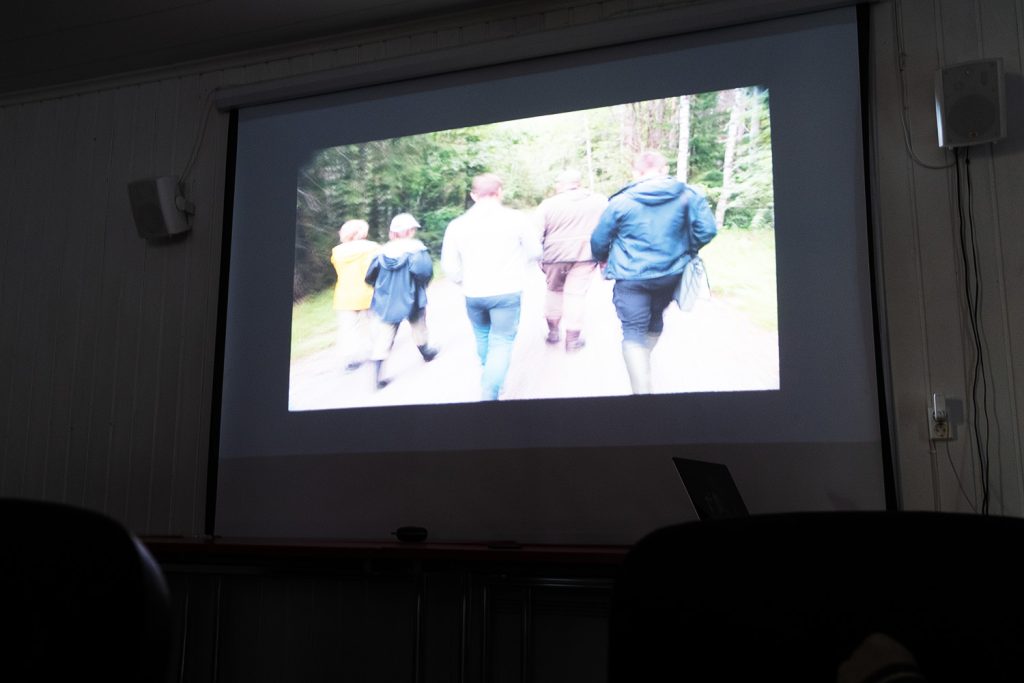
The lovely Once upon a time in the forest (Havumetsän lapset)!
Chants as a collective force and a political art form / Lea Lintula
On Sunday morning, we were woken up to the sound of community by the sea. Together we were reflecting on what makes up a snappy swordfish call and how to develop them. This workshop made us empowered by the shout and invited us to think about shouts as a political art form. The workshop took place at the sea shore which made it possible to squeeze everything out of our lungs!
collective power, use of voice/exclamation,
political embodiment, agency, demonstration, tool
More about powerful civic activism and everything what Lea is busy with on Instagram:
@lelelintu
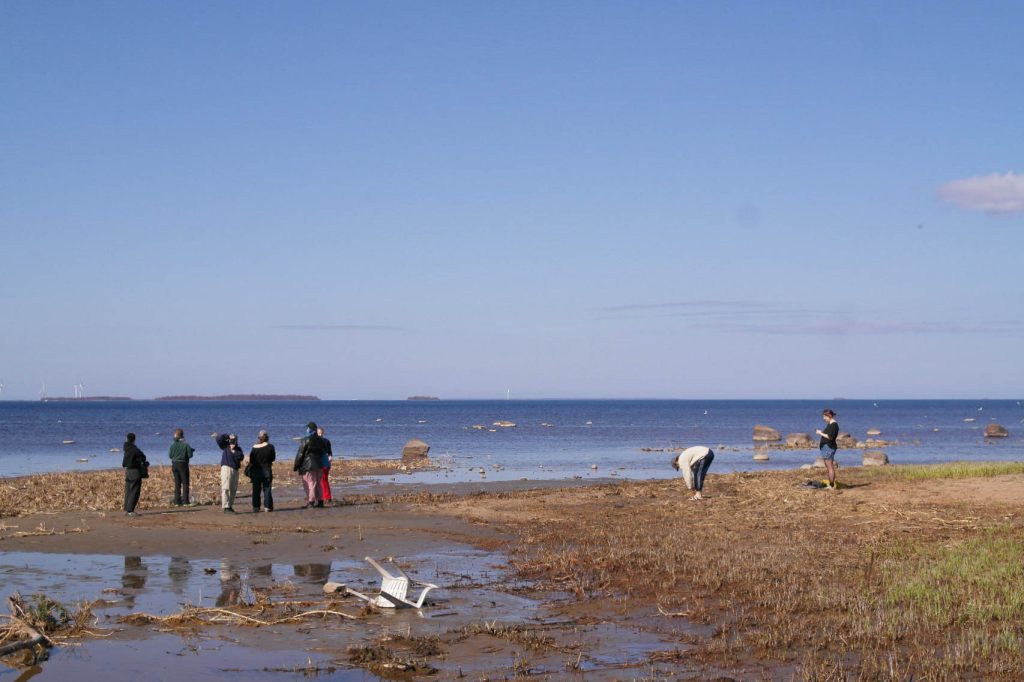
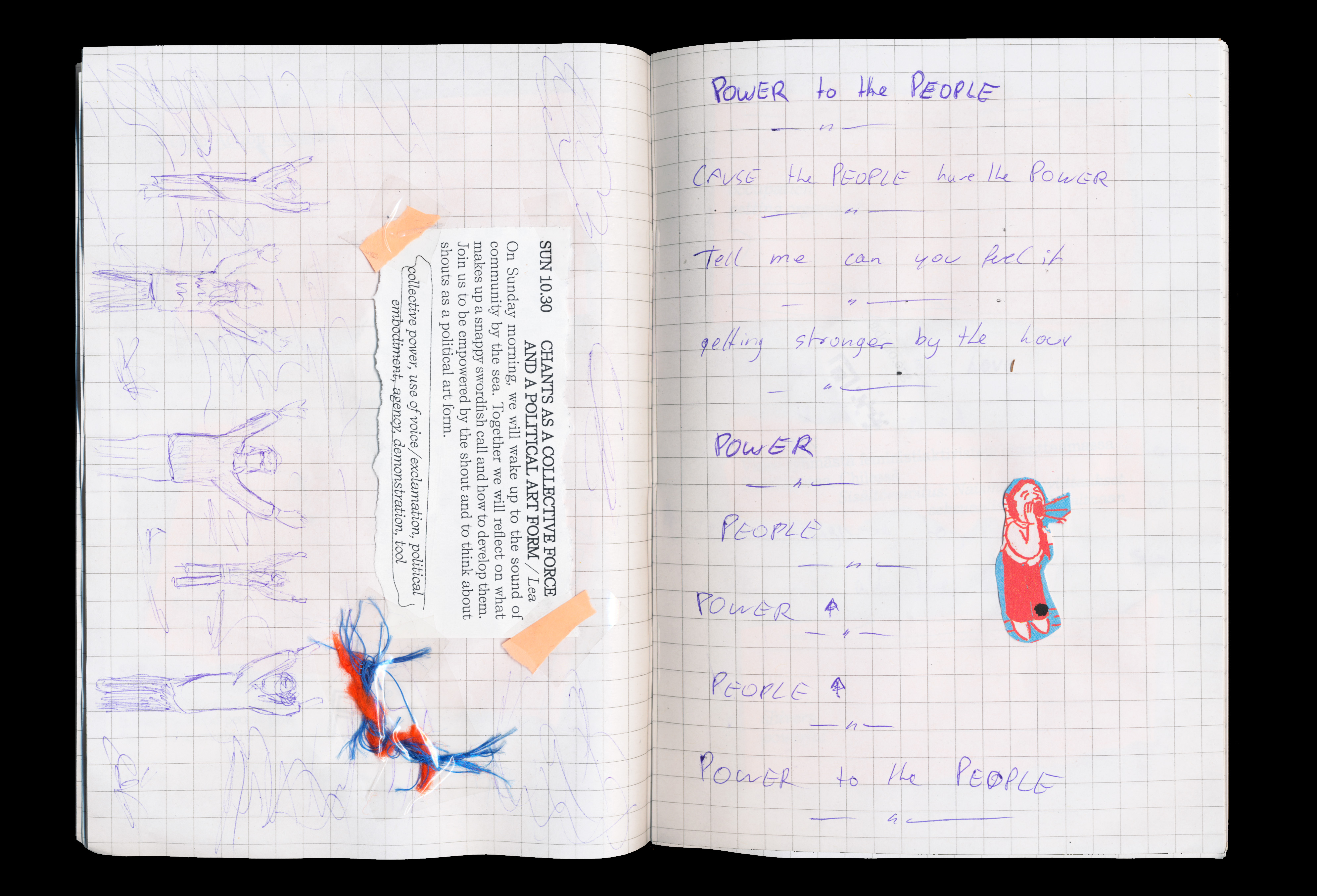
Notes made during the workshop, by one of the participants.
Effective communication in activism / TAIVO
Practical workshop exploring communication related to protests / actions and its effectiveness. How to deliver the message and get media attention? This workshop taught us how to organise – effectively. What are the key points, which make actions effective? Are there some things that always should be considered and reflected when designing and action of any kind? What are the ways of getting media coverage and exposure for your agenda?
goals and target group, media, communication, narrative
More about TAIVO group and their different projects in the Oulu region:
https://taivo.org
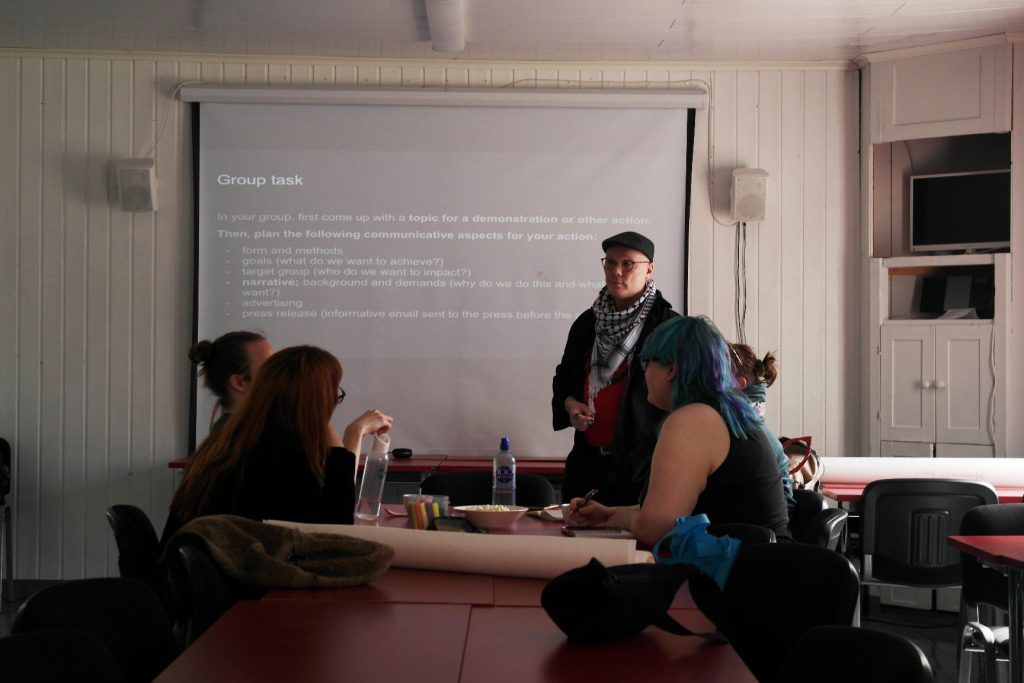
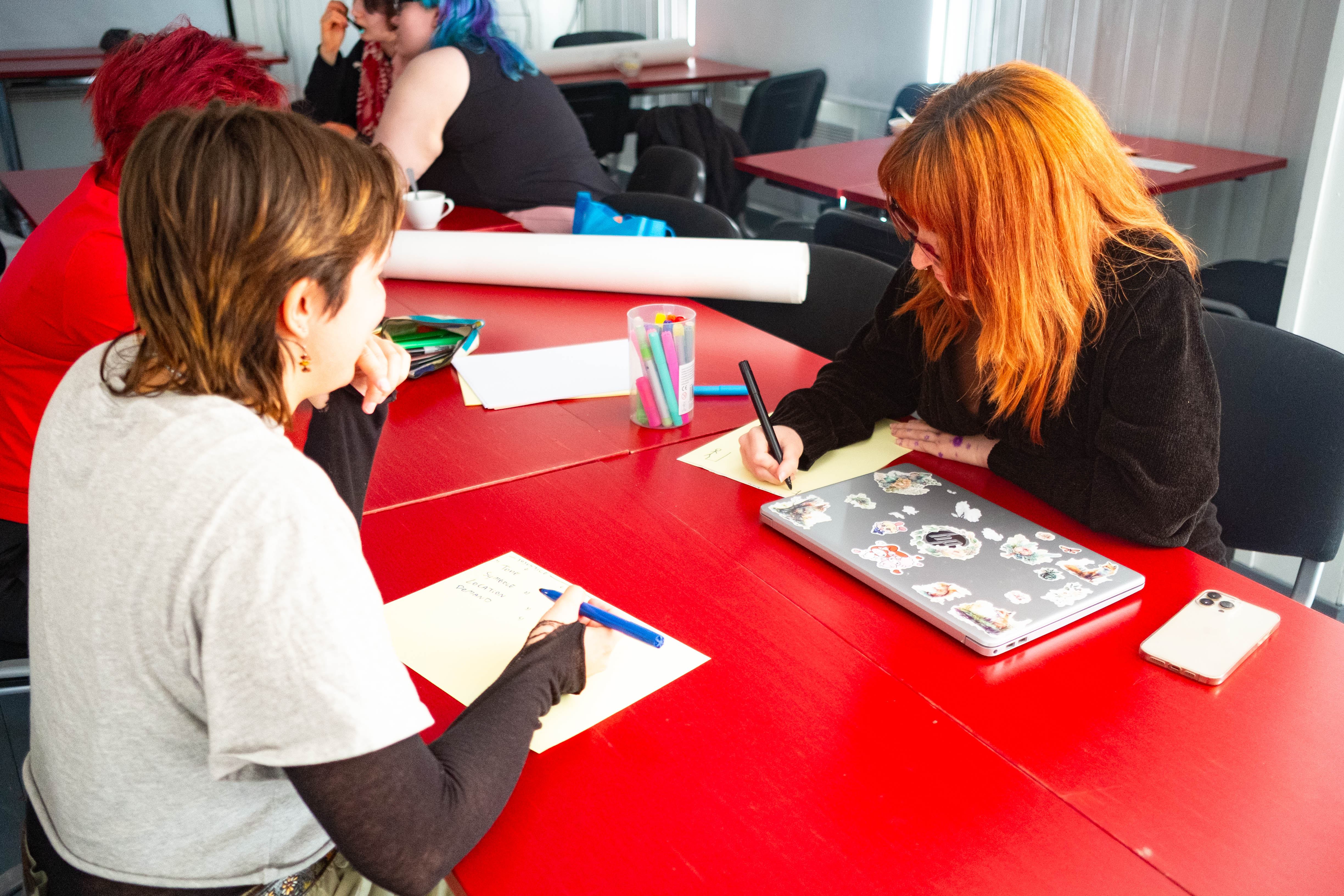
Action design / Wilhelm
In this workshop we dove into the key elements of every action, making a plan for an action and then reflecting on the choices that we made. The workshop invited to work with a dynamic approach and to learn to trust the process. In this workshop a lot of things from previous workshops came together – the approach invited to get creative and come up with new things and takes on different topics, but also to work together in a dynamic setting while using the recently obtained knowledge about effectivity and the key elements. The outcomes of this workshop were many new, interesting ideas and very impactful action designs. What a way to wrap up this weekend!
tools, strategy, targets, tactics, audience, action logic, beautiful trouble

A countless amount of notes, plans, sketches, and whatnot were made by this red table during the weekend.
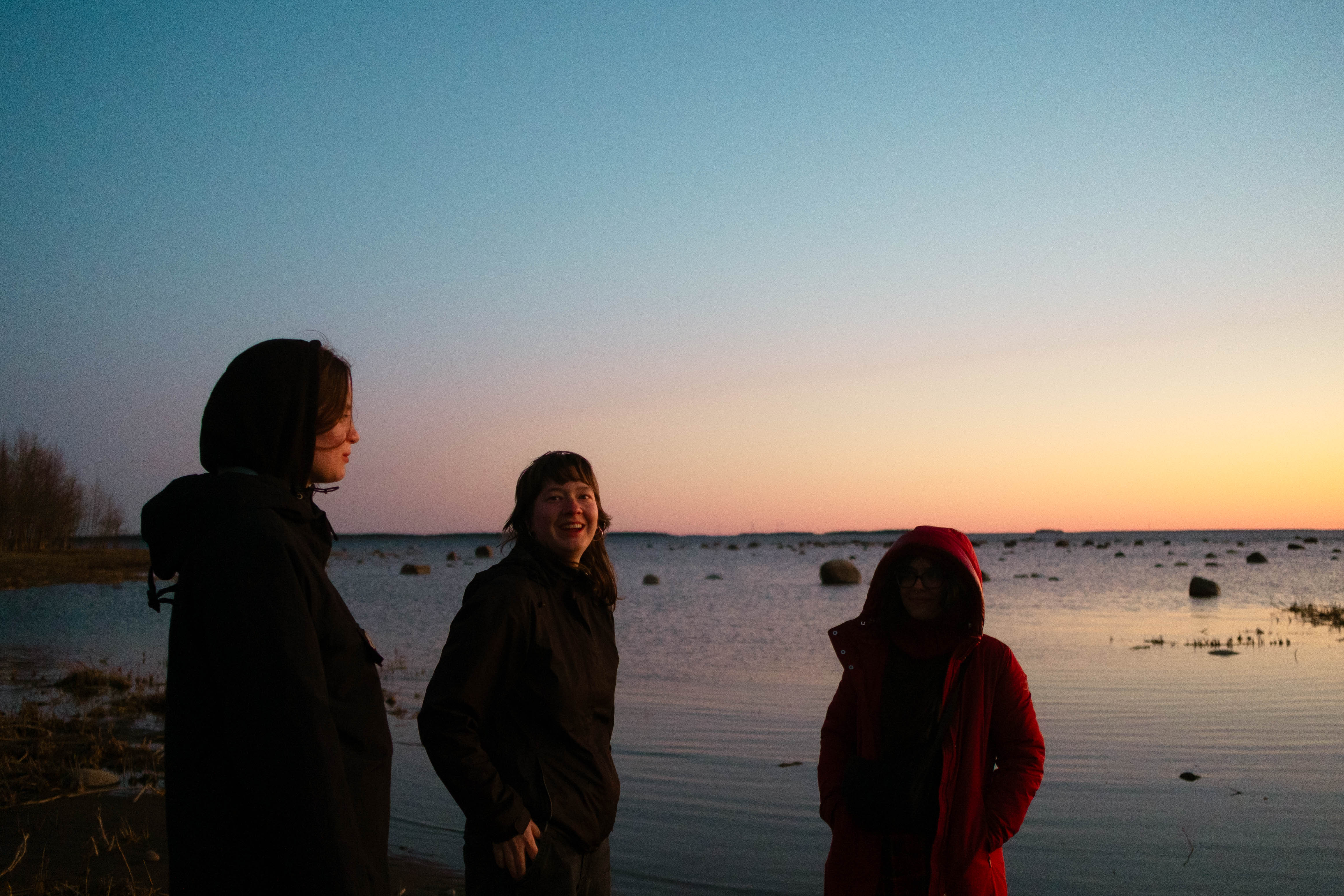

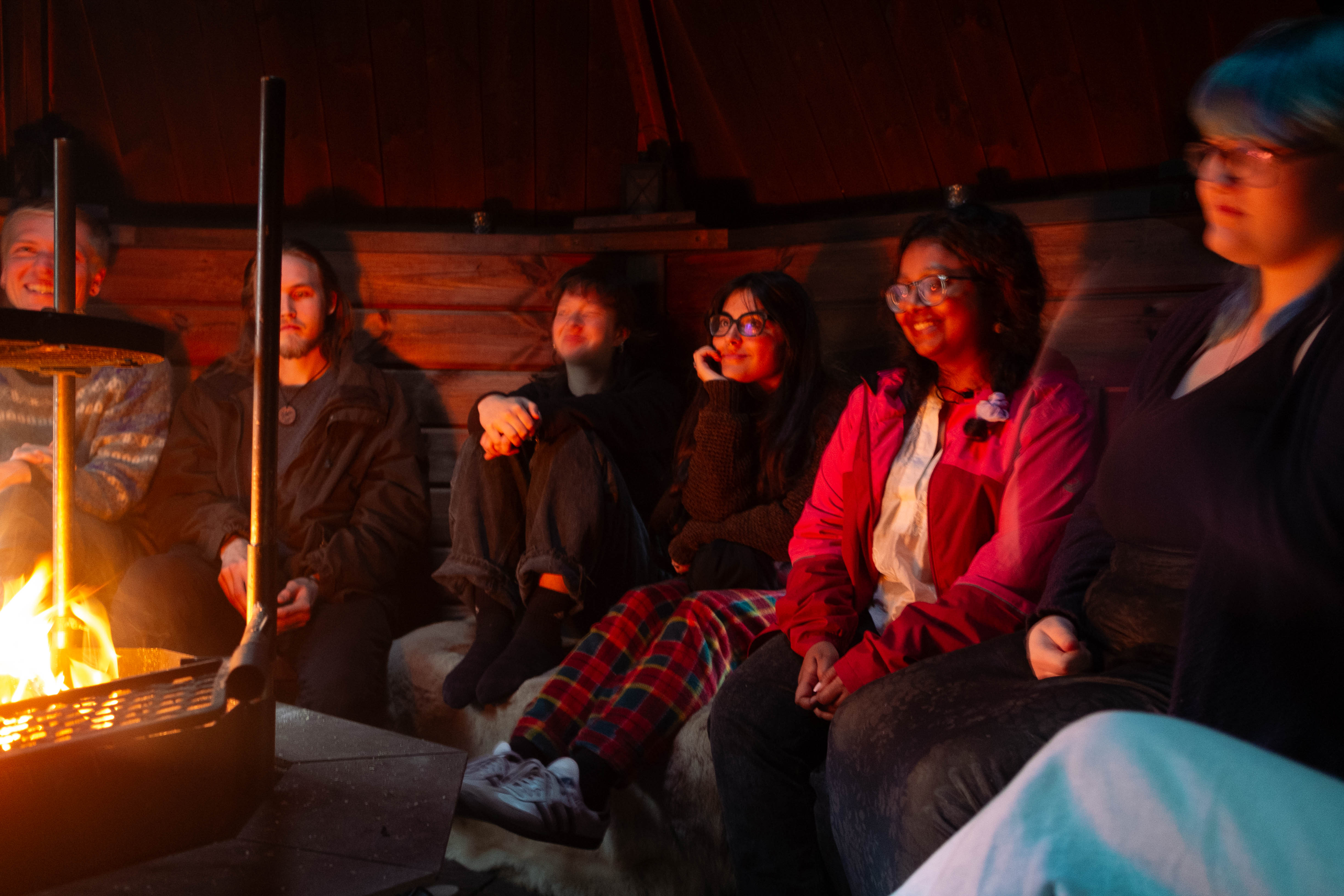
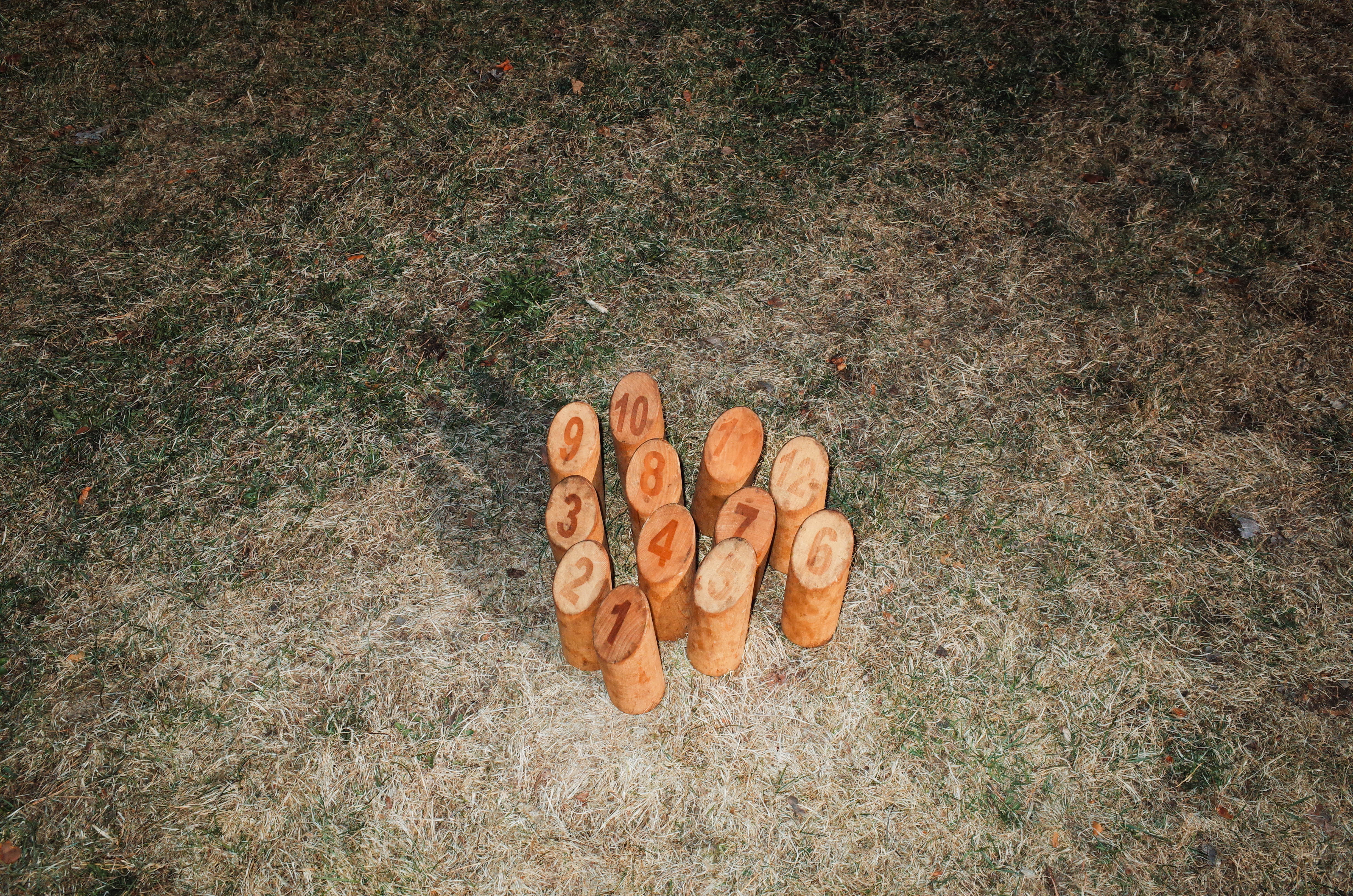
Food, yard games, relaxed socialising and debriefs the contents of the weekend.
This time in total of 20 young people attended this Action weekend. The participants and workshop facilitators arrived from all around Finland — some of our important goals for this weekend were to bring people together broadly from different places and to provide a possibility to join such activities from more rural or distant areas. We were happy to see these goals to be met well and especially we were happy to receive good feedback about creating this chance.
Ideally, the program and all the workshops would have given enough new information, skills and perspectives that the participants would leave back home eager to study all of it further. We it also did! On top of the program, the weekend also provided a great setting for relaxing, creating new connections and making friends, enjoying the sauna and taking some initiative. The meals, dishes and keeping the place tidy were handled collectively, allowing everyone to contribute according to their abilities. It truly felt like everyone was involved in creating the lovely atmosphere and making this weekend an unforgettable experience. We extend our heartfelt thanks to all the organizations and individuals who helped make this incredible weekend a reality—this would not have been possible without you!
Thank you all!
The rest of the year 2025
In 2025, as the last theme of this project will be utopias! More info about the events happening under this theme soon. Find out more in the newsletter and on the social medias! The last study group and the Action weekend will both take place in Helsinki!
If you are interested at this stage in the project and its future developments, please feel free to contact us! We welcome new ideas, thoughts and comments. If you are looking for meaningful activities and places to meet like-minded people, come and volunteer to organise them!
If you are interested, you can send a message directly to the project coordinator, Jonne (“name”@dodo.org).
*
A Brief Overview of 2024
Themes: Activism and Art
Activism (Spring)
The Towards Action project kicked off in early February with a study circle. Our plan was for each six-month theme to have its own study circle and activity weekend. The study circles would consist of multiple sessions and could take the form of reading groups, workshop series, or perhaps a hybrid of both! While we had clear guidelines and objectives, we aimed to keep the project’s activities and structure flexible so participants could influence them and become part of the project’s evolution.
Study group 1/24
“Communities, Connections, and Action”
Helsinki
Our first study circle took place between February and May, meeting every other week. This circle focused on radical friendship, communities, and the significance of community as a foundation for change. These themes were explored through gatherings filled with discussions, questions, shared experiences, and ideas. A cornerstone of our study circle was the book We Belong to Each Other – Letters and Writings on the Politics of Friendship.
We Belong to Each Other – Letters and Writings on the Politics of Friendship is a book by Mikael Brunila, Vilja Saarinen, and Valter Sandell, based on their correspondence and addressing friendship and sharing on both personal and theoretical levels. It was published in 2023 by the Finnish independent publisher Khaos Publishing. We warmly thank Khaos Publishing for their support in making the study circles possible! The book guided us into discussions that became catalysts for the formation of community, the development of trust and a sense of belonging, and countless eye-opening conversations!
n their correspondence and addressing friendship and sharing on both personal and theoretical levels. It was published in 2023 by the Finnish independent publisher Khaos Publishing. We warmly thank Khaos Publishing for their support in making the study circles possible! The book guided us into discussions that became catalysts for the formation of community, the development of trust and a sense of belonging, and countless eye-opening conversations!

The book and a letter written during one of the sessions.

When the Spring really arrived, we moved the sessions to Dodo’s greenhouse.

Page no. 103, notes, flowers.
The Action weekend, May 3-5
Elävän Kulttuurin Koroinen, Turku
The project’s first action weekend took place at Elävän Kulttuurin Koroinen in Turku from May 3–5, coinciding with the awakening of spring in southern Finland.
The weekend was organized in collaboration with Elävän Kulttuurin Koroinen, Koroisten Maailmanpyörä, and artists who curated a human rights-themed art exhibition called Seeds Are Sprouting as part of the event. We had planned a comprehensive program to explore the diverse intersections of activism in a multifaceted way. Various organizations contributed to making this possible, including Somor Sur, Elokapina, and Amnesty Finland.
The entire weekend unfolded in the stunning surroundings of the Koroinen farm, blending workshops with rest and recovery, sauna sessions, and communal meals. Meals, dishwashing, and maintaining order were handled collectively, allowing everyone to contribute according to their abilities. We extend our heartfelt thanks to all the organizations and individuals who helped make this incredible weekend a reality—this would not have been possible without you!
A total of 16 young participants attended the action weekend. Participants stayed actively connected after the event, and based on feedback, it seems the weekend was a resounding success. From the organizers’ perspective, this was the first time we held a larger event outside Helsinki, and it was incredibly rewarding to see the weekend’s content spark discussions and encourage participants to view issues from new perspectives.This first action weekend also gave us renewed inspiration to explore additional ways to bring people together and create communal, unifying spaces.

There were different workshops held over the weekend, which of one guided the participants to investigate different barriers and privileges, which could affect on one’s possibilities to be an active citizen.



Discussions, co-learning and critical reflecting of the current state of the World. And Sirius the cat, who lives in the farmhouse.
With a weekend full of planned content and various workshop opportunities, we wanted to highlight the importance of personal space and rest as part of the Weekend of Action. The setting of Koroinen was a great place to relax between workshops, hang out in the hammock and soak up the spring nature. Participants were encouraged to take their own breaks and space. The old farm setting, full of art and unusual structures (where there is still activity, much of it strongly community-based and social) was the perfect setting for the Action Weekend.

Koroinen surroundings, lovely people, tree leaves about to open.
Thank you!
*
Art (Autumn)
The experience we gained in spring—bringing people together, creating communal spaces and activities, and developing inspiring, agency-focused content—served as the foundation for autumn’s planning. We wanted the project to remain dynamic and experimental, retaining some familiar elements while actively making space for the new. The essence of autumn’s content was bold experimentation and creative engagement.
For the autumn study circles, we decided to try a different approach: each session would have a different facilitator. In spring, the study circles were organized as closed groups, with the same participants throughout the series. This time, we opted for individual registration for each session, as both the organizing body and session themes varied slightly each time.
The autumn Action Weekend was held on the last weekend of October in Pispala, Tampere. We structured the weekend so that activities took place simultaneously at various locations across the Pispala ridge. During the autumn, we launched an open call for individuals with expertise in art and activism to share their knowledge during the Action Weekend. The open call received an overwhelming number of responses, from which we selected a diverse group of contributors to create a well-rounded program. This relatively organic process resulted in a weekend that featured various workshops, an art walk, and more.
Study group 2/24
“Liminal Space“
Helsinki
The guiding principle for this autumn’s study circle was to act as a facilitator for action, offering new and even unexpected approaches, and exploring spaces where creativity and agency intersect. A liminal space is something whose existence and function are not entirely clear. A too-small entryway without room to dress or store shoes is a good, everyday example of a physical liminal space—something in between that rarely captures attention.
The concept of liminal spaces is abstract and open to interpretation, representing areas not tied to clear functions. These are also spaces where creativity and renewal often reside. This autumn, the study circles focused on examining these spaces and experimenting with creativity and the experience of liberation.
We wanted to bring in fresh perspectives and held an open call, which attracted a wide range of contributors to the project. One of the application questions was: “What do liminal spaces mean to you?” The responses and interpretations of this concept were surprising and diverse. Beyond physical spaces, liminal spaces were also identified as time (the present moment) and as emotional or embodied spaces emerging from social dynamics.
Ultimately, we developed a six-session study circle series, partly based on proposals from the open call and partly by inviting collaborators familiar to Dodo. Throughout autumn, liminal spaces, creativity, action, and agency were explored from various perspectives using diverse tools. Each workshop was held in a different location across Helsinki, chosen by the session facilitator.
Below is a summary of all six sessions and their core approaches in the facilitators’ own words.
I
CONTRAST (September 11)
Pasila, Helsinki
“This is an invitation to explore the contrasts of urban spaces and the environments we inhabit. During our gathering, we will create a collective installation where the present moment, our emotions, and our relationship to the spaces that confine us will come to life.”

II
BUSHES (September 25)
Arabia, Helsinki
“In nature, biodiversity thrives most vibrantly in liminal spaces: transition zones at the edges of forests and fields, wetlands between water and land. Similarly, urban wastelands, vacant lots, and overgrown thickets provide habitats for meadow plants that cannot survive in densely grown, shaded forests.
However, it is estimated that one in nine species in Finland is at risk of extinction. The list includes the Arctic fox, three species of salmon, centipedes, and nearly half of Finland’s birds, such as the magpie. What kind of liminal space is it to exist on the brink of extinction? What does a space look like where a species has disappeared?
In our next study circle, we will explore these questions through the medium of painting, reflecting on ways to halt biodiversity loss through art.
The session includes an introduction to the topic, ample room for discussion, and an opportunity to create your own artwork. These pieces can be part of an installation or repurposed as signs for demonstrations.”



III
KAISLA (October 9)
Rastila, Helsinki
“The increasing complexity and the intertwined web of escalating crises show that the path of control and domination has reached its end. In the KAISLA workshop, we will explore how to coexist with living systems without the need to control them.
We will remember that creativity and play reside within us. We have the ability to take risks, to feel, and to make mistakes. We are part of the nature that holds the wisdom to stand grounded yet bend gracefully in the wind—like reeds.”

IV
STITCHES (November 6)
Metsälä, Helsinki
“Ton and Masha share their experiences with protest through textiles, clothing, and direct action. The themes of their work include students, women, workers, LGBTQI+ rights, ecological issues, and anti-war activism.They will discuss their projects, including those they co-founded: the sewing cooperative Shvemy (a Ukrainian-Russian art collective), the sewing cooperative Resew (an experimental economic and community project), as well as their experiences with creative work in collaboration with communities.”
V
THE SURROUNDING BODY (November 11)
Itäkeskus, Helsinki
“Why do I feel alone in a crowd? How can we be so close to each other yet remain unreachable? Is there care to be found in shopping malls or metro stations? How can I shake up my environment? How can I tap into the adventure and magic around me? How can I hide in public space?
In Finland, the culture of following rules and maintaining the status quo is a deeply ingrained, socially esteemed norm. A good example of this is the social and infrastructural spaces of urban areas, which shape our bodily movements, focus, and emotions—while much of this supports the goals of a homogeneous white identity. Our movement is directed by the rules of privatization and capitalist consumption. Could we find more room for connection and play than what is currently allowed?”

VI
STORM (November 20)
Kalasatama, Helsinki
“In the middle of Kalasatama’s planned urban environment lies a forgotten place. It might be called a liminal space, wasteland, leftover area, or surplus. But what is the role of the place itself? How do we interact with it?
Now, a yarn storm arrives in Kalasatama. In this study circle, we will crochet a temporary artwork in a place that was once the sea and now awaits something yet to come. While crocheting, we will reflect on the different layers of the space and the significance of art as a creator of place.”



We gathered at Kalasataman Vapaakaupunki to discuss, do some preparations and to get to know each other before heading out to one of the last bits of waste land in Verkkosaari, Helsinki.



Storm details in daylight.
The artwork was disassembled and collected two days afterwards. The yarn used will be reused in an upcoming workshop (more info about this on IG and in the newsletter!)
The Action weekend (October 25-27)
Pispala, Tampere
The autumn Action weekend was held in Tampere, Pispala. The weekend was organised in cooperation with Hirvitalo and Pethaus -among others- and a large part of the activities took place at these locations. In addition, we had a third indoor space where accommodation and meals were mainly provided. Some of the workshops and other activities took place outdoors, in the beautiful scenery of Pispala. In contrast to the spring activities weekend, all activities this time were spread out over the Pispala ridge, in several different locations. This created a dynamic all of its own – allowing several activities to take place at the same time, but also creating a sense of fragmentation and complexity to the weekend. The first two Action Weekends of the project ended up being very different from each other.
In fact, the Action Weekend in Tampere was even a bit like a festival, with things happening in different places at the same time. Some of the workshops and other content were found through an open call campaign earlier in the autumn, others through contacts already made by Dodo. We wanted to provide opportunities to showcase our own practice and build a workshop concept around our own work and approach. The workshop facilitators had a fairly free hand to build something that they felt was workable and inviting. The nine workshops and art activities that were organised came together in a fun way, and the participants were able to see what they were doing.


The handout guide of the event.
The workshops allowed participants to explore activism and creativity: they covered topics such as embodiment and somatics, small publications and the possibilities of self-making, legacies and traces and stories, visual art and media, different materials and the possibilities they create, community-based making and communities, and how we act as part of them. Below a small introduction to the workshops, which took place during the weekend.
Belonging/Roots
In this beginner friendly somatic workshop we will explore the nature of embodied emotions and the feelings of interconnectedness. How do emotions invite one to be, to move and to respond to the outer world as well as to one’s inner world? The instructions are in English and Finnish. The workshop is held mainly outdoors and is facilitated by Anthoni Levonsaari, Drama Instructor (BA in Performing Arts), who specializes in Dance and Somatics.
Zine Practice in Activism
Come and learn about the transformative power of the grass-root practice of zines that transcend censorship and carry information heart to heart. Comic artist Elvira Kim, an author of “My friends from Russia are disappearing” will share their experience and encourage you to create a zine about things you were forced to be silent about.

Left: Elvira’s zine workshop
Right: ReSew cooperative presenting ways to creatively use textile as a form of activism.
Resewing capitalism to queer-fem-anarchism
Ton/Tonya Melnyk and Masha Ravlyk are artists and activists from Kyiv (Ukraine), participants of Shvemy and Resew sewing cooperatives, queer people and refugees. They will make a presentation about their experience in making protests through textile, clothes, and direct action. After that (or at the same time) they will conduct an embroidery workshop. The threads and pieces of textile will be provided, but feel free to bring yours if you wish.
Trashcape
Trashscape is an experimental excavation of the Anthropocene, wherein fly-tipping* sites become archaeological digs, museums, and art exhibits. The project serves not only as a platform from which to interrogate and critique human-kind’s consumerist nature; but also from which to playfully investigate language, to imagine possible futures, and to question the nature and definition of art and beauty.
Trashscape is brought to you by the art collective Translation flowers (Inkeri Jäntti (FI), Nancy Dewhurst (UK) and Sunčica Pasuljević Kandić (RS)). Initially the project will focus primarily on sites in Oulu, Finland. However, ultimately the trio plan to expand the project into Berlin, Novi Sad, and worldwide!

Polaroids taken during TRASHCAPE workshop (picture: Inkeri Jäntti)

(picture: Inkeri Jäntti)
Rage crochet and Yarn Storming (a two-part workshop)
Learn to crochet in stream-of-consciousness style and unravel your thoughts and feelings into the knots of yarn! In this workshop, you will learn the basics of crochet. The workshop is also suitable for experienced crocheters as a new technique to explore. The creations made in the workshop can be used in the second part of it in the evening, or you can choose to participate in just one of the workshops. There are no pressures or goals in this crochet workshop; you decide what you’ll make and how to do it, and the instructor will assist you.
As evening falls, we will direct our crocheting into a chosen location in the public space at Tampere.Yarn Storming is a form of street art where surfaces are covered with crochet or knitting, or eg. urban planning issues are highlighted by drawing attention to them through yarn.

Different surroundings of the workshops – in the old wooden houses, in the woods, on the streets.


Yarn storm, before/after (by Verna Talvi) .
Community forum
This workshop will be facilitated by someone who has been inspired by the study group of last Spring. We will gather in order to inspect the meanings of community, communal agency and friendships. Interested in rhizomatic thinking and creative approaches to community building? This forum is for you!
Pispala art walk, Pyykkipuisto gymnastics, Hirvitalo folk kitchen…
In addition to the larger workshops, participants had the opportunity to take part in body care and relaxation exercises, The Pispala art and activism history walk organised by the Hirvitalo actives, the Hirvitalo folk kitchen and other similar activities throughout the weekend.
Artivist café
On Sunday, the art exhibition took place at Pethaus as part of the Action weekend. People from different backgrounds and connections were invited to this exhibition, aiming to create a place to come together, make new acquaintances and networks, and build community. The exhibition featured artists from all over Finland, many of whom were from immigrant backgrounds and/or not from the academic art world. The exhibition focused on activism through art and meeting people. The weekend of activities gave participants the opportunity to discuss and exchange ideas with the artists participating in the exhibition, to learn about different ways of doing activism through art, and to relax after a hectic weekend with a bun and coffee in the warm atmosphere of the Pethaus grass root culture center. The exhibition was open to all and we were delighted that it also attracted local visitors. This created a setting that allowed for new encounters and conversations over a free bun and coffee.

The event participants and artists participating to the exhibition had discussions and got to know each other during the exhibition. (picture: Inkeri Jäntti)
The idea behind the range and diversity of the workshops was to enable different experiences and learning new things in an intersectional way, exploring different aspects of art and following our own interests. Most of the workshops were held on Saturday and the participants were able to go from one workshop to another from morning to night, according to their own ability and mood.
We were able to create a whole where aspects of art and agency were addressed in a broad and diverse way – made possible by all the artists who offered their expertise and practice in the open call, as well as the experts found through Dodo’s activities. We would like to thank separately each workshop organiser, Pethaus and Hirvitalo for letting us use their facilities, as well as the volunteers and workshop leaders involved – and of course each and every participant! We hope that everyone who participated left with new ideas, inspiration and some tools to explore their own agency through art.
The Action weekend was really intense, but also rewarding and made us once again look at what we can and want to offer. We managed to bring together a lot of activities and forms of making that rarely come together. The weekend also provided ample opportunities for making new connections, learning about ways of working and skills, exploring creativity and creative methods as a form of action, and exploring our own agency and meaningfulness. This time there was a lot of everything: activities, places, things to do, surprises.
Phew! Thank you!
*
